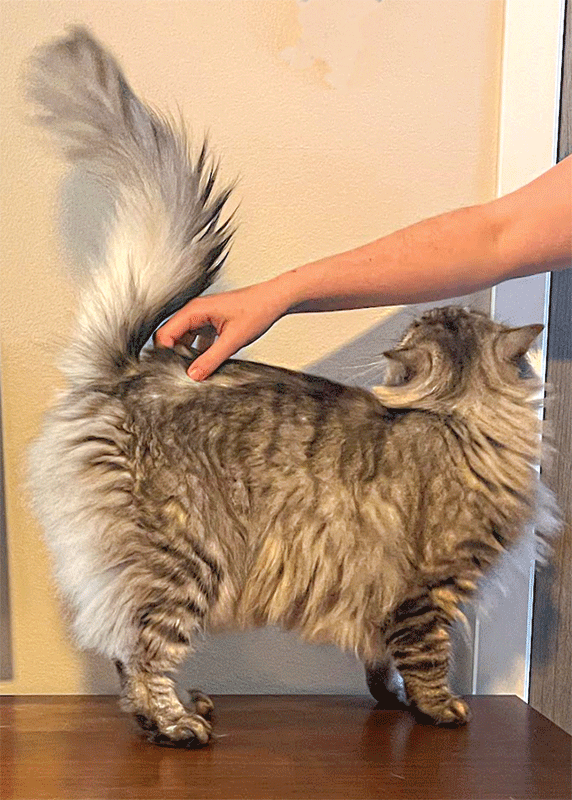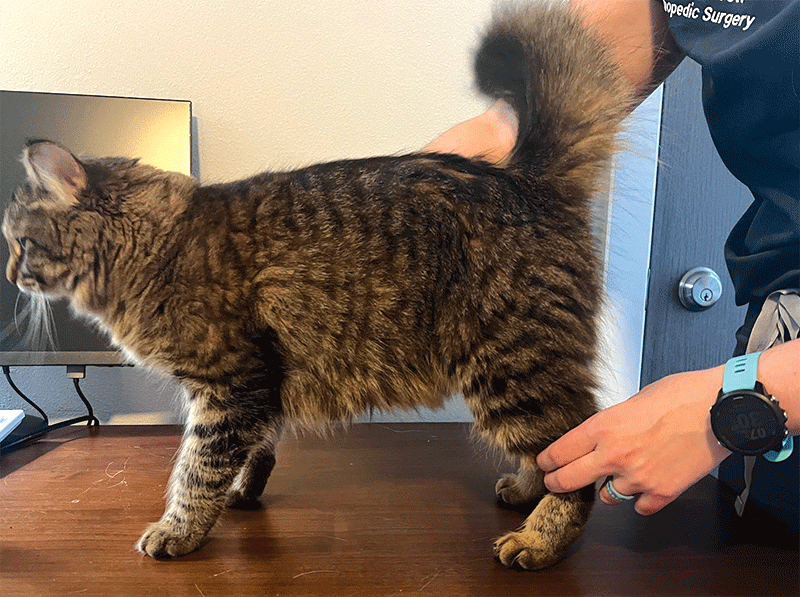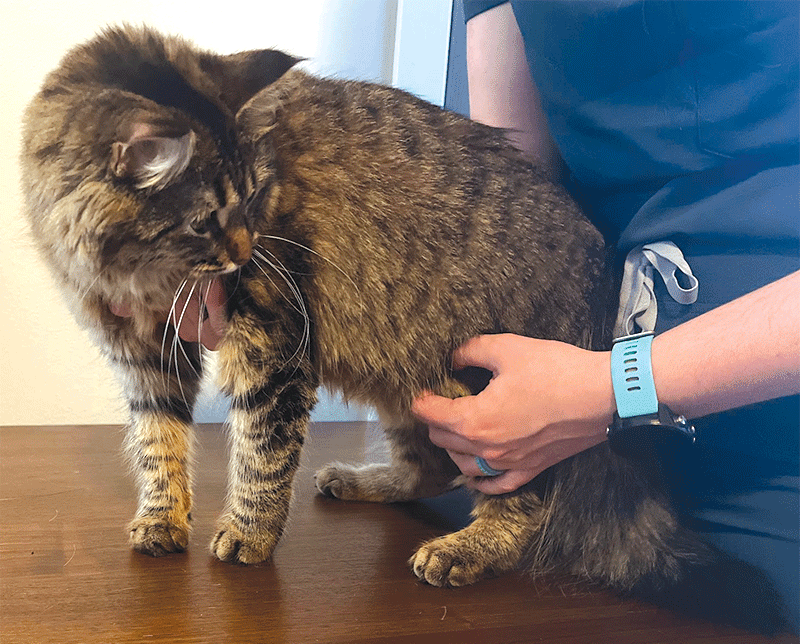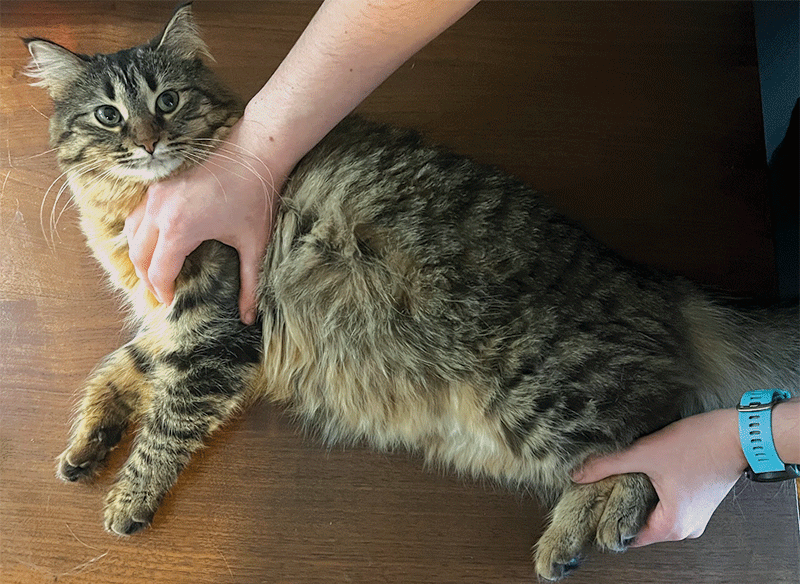Feline orthopedics and recognizing lameness in cats have been a growing area of research we are continually learning more about, along with the appropriate treatment options.
The first step in trying to understand feline orthopedics is to understand how to perform an appropriate feline orthopedic exam.
Research has shown a high prevalence of degenerative joint disease in cats. At 12 years of age, an estimated 90 percent of cats will have radiographic signs of degenerative joint disease, with at least 40 percent showing clinical signs related to pain.1 However, even with this high prevalence, degenerative joint disease in cats often remains underdiagnosed. This is likely because cats show a lower prevalence of single-limb lameness compared to dogs and overall lameness is not usually observed. Instead, osteoarthritis is more likely to manifest as a subtle stiffness or reluctance to do their normal behaviors such as grooming and jumping.
Obtaining a good history
To make observations of lameness even more challenging, cats do not always perform the same behaviors in the clinic as they do at home. Due to this, owners are a critical part of the diagnosis and monitoring of degenerative joint disease associated pain. Taking a good history and discussing clinical signs at home with the owner is incredibly important. Suggested questions include:
- How is the cat’s ability to jump up and down? Do they struggle to get up onto high surfaces?
- How high is your cat able to jump?
- Has your cat become more difficult to handle as it has aged?
- Does your cat seem quieter or less likely to interact with you at home?
- Is your cat less playful with toys or other pets?
These questions can start a discussion with owners and help draw their attention to a potential lameness they may never have appreciated before.
Another step that can be taken in conjunction with obtaining history is capturing videos of the cat at home. Good quality videos are important, so consider producing a short informative email or information sheet with advice on how to capture a suitable video for owners. A well-lit space without furniture obstructing the view and good lighting will help. Ask owners to record the cat walking toward them, walking away from them, as well as a video from the side. If the owners notice a lameness following a specific activity, have them record the activity to see if a specific action may be contributing to the lameness.
There are many validated orthopedic owner questionnaires available to evaluate degenerative joint disease in cats, including The Feline Musculoskeletal Pain Index, which is a method to identify potential lameness and pain more accurately. This has been further refined to a short form with more accurate reporting.2 This updated shortened version had similar reliability but improved responsiveness.
Utilizing these validated questionnaires help not only develop a baseline understanding of potential lameness and orthopedic disease in cats but can be used for follow-up exams when monitoring for long-term arthritis management.
The orthopedic exam
When evaluating cats, the structure of the exam is the same as an approach to the standard orthopedic exam in the dog; however, with cats, much more patience and careful, methodical examination is recommended because many cats may have a limited amount of time for evaluation.
The three main component of the orthopedic exam are:
- Gait analysis
The gait analysis takes the most time and patience since you cannot (in most cases) walk a cat on a leash as you would a dog.Before even starting the examination, make sure windows and doors are closed to ensure the cat cannot escape. There should be no areas where the patient can hide or potentially get stuck. When picking a room, ideally it would be somewhere without any dogs, such as a feline-friendly exam room with treats to help keep the cat calm.
For the examination, place the cat in the center of the room and move its carrier or basket to one side as the cat may be more likely to head towards that “safe space.” Some feline patients may be motivated to play with a laser pointer, toy, or move towards a treat. Performance tests can be done where the cat is placed on the floor to see if it will jump up or potentially will display reluctance. It is also important to evaluate the cat when standing or sitting. Does it seem to be holding up a limb or slightly offloading?
Bilateral orthopedic disease may not show a distinct lameness, but the cat may just walk crouched or be reluctant to jump or interact. Additionally, when walking, you can sometimes observe a “tail shift,” where the cat shifts their tail to put more weight onto the “sound limb.” Even with a dedicated feline examination room, time, and patience, it is often only possible to see a few steps. Many cats tend to walk with a crouched posture at the clinic, making it more challenging to identify lameness. Due to these challenges, an alternative lameness grading scale in the textbook of Feline Orthopedic Surgery and Musculoskeletal Disease.3
- Standing exam
The standing part of the orthopedic exam is important to compare limbs and evaluate for asymmetry. When performing the exam, it is important to use the least amount of strength as possible. The examiner can place one hand under the cat’s abdomen, similar as with a dog, to lift pelvic limbs and keep the patient in a standing position. Some cats may not tolerate this, so gently scratching the base of the tail can help to motivate them to stand up (Figure 1).
Figure 1. If the patient is unwilling to stand while performing the orthopedic exam, scratching the base of the tail many times will motivate them to stand up. Photo courtesy Dr. Faolain Barrett Weight-bearing symmetry can be tested while the cat is standing. For the pelvic limbs, gently pull on the metatarsus in a caudal direction with two fingers as this will cause the cat to unload the limb (Figure 2). Resistance to unloading the limb will be greater on the unaffected side.

Figure 2. Weight bearing symmetry can be tested while the cat is standing. For the pelvic limbs, gently pull on the metatarsus in a caudal direction with two fingers as this will cause the cat to unload the limb. Resistance to unloading the limb will be greater on the unaffected side. Photo courtesy Dr. Faolain Barrett In the thoracic limbs, push the area of the accessory bone cranially and assess the resistance to knuckling over. Resistance to knuckling over will be greater on the unaffected side.
Finally, palpate and note muscle mass and tone in both the thoracic and pelvic limbs. Make sure to compare the contralateral limbs. Fully assess each limb working from distally to proximally, palpating long bones individually and flexing/extending each joint individually (Figure 3). Take care when palpating the lower back; many cats may not tolerate this.

Figure 3 When performing the standing orthopedic exam, a gentle hand can be placed under the chest for support. With the other hand, the long bones can be easily palpated, and the joints can be palpated, flexed, and extended for effusion and crepitus. Photo courtesy Dr. Faolain Barrett - Recumbent exam
The final part of the exam is the recumbent exam. Scruffing is not necessary for most cats in a quiet, calm environment where they can relax and be amenable to an exam. Hold the cat with flat hands around proximal thoracic and pelvic limbs (Figure 4). One hand should be on shoulders around the neck to avoid turning its head and biting. All limbs are then systematically examined. Palpate for crepitus, hyper- or hypo-extension of joints. Always compare to the contralateral limb; cats can fool you since they are way more “bendy” than dogs. Pain responses can be as obvious as hissing or turning of the head, but can also be more subtle such as change in pupil size, breathing pattern, and positioning of ears. Finally, look at the nails on the cat’s thoracic limbs. If they are overgrown, they may not be using them as much, which can be associated with elbow or other joint pain. Just take care with examining feet as most cats do not like this.
Figure 4. Scruffing is not necessary for most cats. Hold the cat with flat hands around proximal thoracic and pelvic limbs. One hand should be on shoulders around the neck to avoid turning its head and biting. All limbs are then systematically examined. Photo courtesy Dr. Faolain Barrett
If your patient is becoming stressed, take a break and then try again a bit later. Sometimes an oral sedation is helpful, but be aware it may mask some subtle lameness and pain responses. For full orthopedic evaluation it can be best to admit the patient for a few hours so there is time to perform a thorough examination.
Jessica McCarthy, BVSc, MRCVS, DECVS, works as a faculty in orthopedic surgery at the University of Wisconsin. McCarthy became a diplomat of the European College of Veterinary Surgeons in 2020, after completing her residency training at the University of Edinburgh. McCarthy attended Bristol University for her veterinary degree and spent two years in general practice in England after graduating. She has a particular interest in elbow disease, both developmental and traumatic, and is passionate about ensuring everyone in the veterinary profession can work in a diverse and inclusive atmosphere.
Faolain Barrett, BVM&S, DACVS is a Clinical Instructor at the University of Wisconsin. Following veterinary school at the University of Edinburgh, Barrett did a one-year rotating internship at the University of Missouri, followed by a four-year residency at the University of Wisconsin. She has a love for feline orthopedics and educating others about the importance of feline health and welfare.
References
- Hardie, E. M., Roe, S. C., & Martin, F. R. (2002). Radiographic evidence
of degenerative joint disease in geriatric cats: 100 cases (1994–1997). Journal of the American Veterinary Medical Association, 220(5), 628-632. - Enomoto, M., Lascelles, B. D. X., Robertson, J. B., & Gruen, M. E. (2022). Refinement of the Feline Musculoskeletal Pain Index (FMPI) and development of the short-form FMPI. Journal of Feline Medicine and Surgery, 24(2), 142-151.
- Montavon, P., Voss, K. and Langley-Hobbs, S., 2009. Feline orthopedic surgery and musculoskeletal disease. London: Saunders Elsevier. Pg.8
